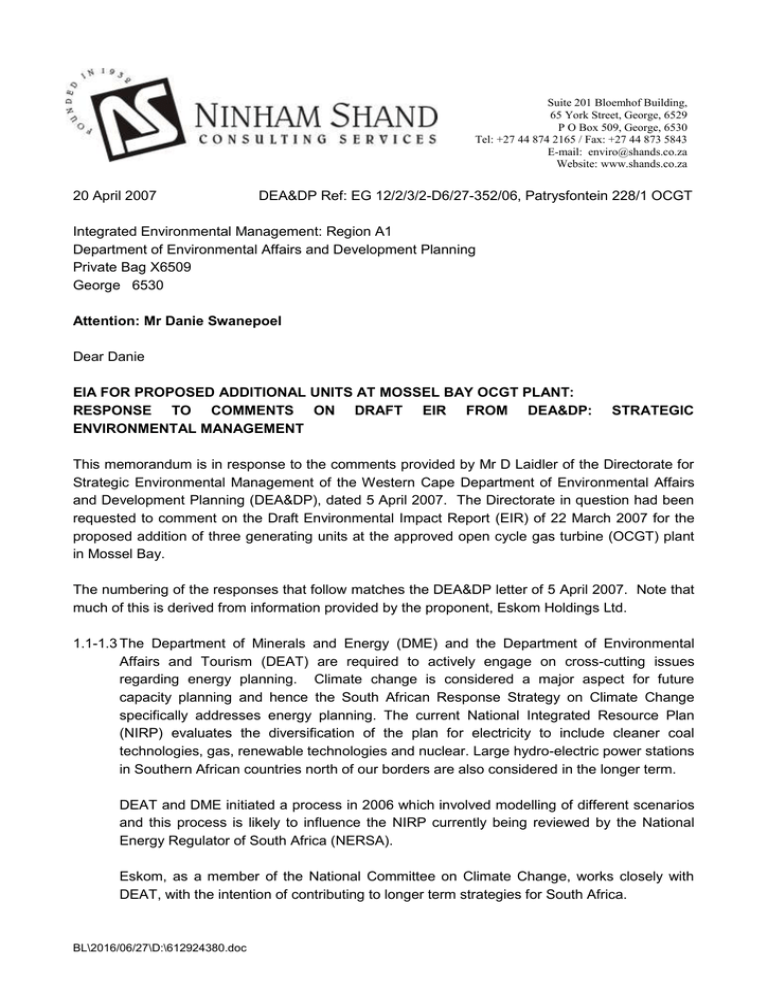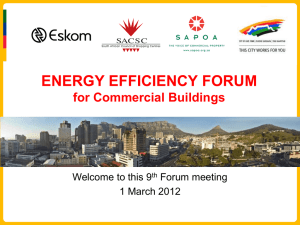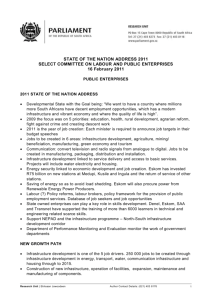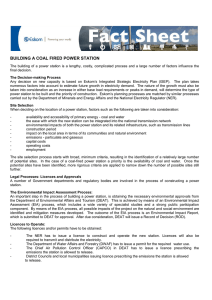Document 14949019
advertisement

Suite 201 Bloemhof Building, 65 York Street, George, 6529 P O Box 509, George, 6530 Tel: +27 44 874 2165 / Fax: +27 44 873 5843 E-mail: enviro@shands.co.za Website: www.shands.co.za 20 April 2007 DEA&DP Ref: EG 12/2/3/2-D6/27-352/06, Patrysfontein 228/1 OCGT Integrated Environmental Management: Region A1 Department of Environmental Affairs and Development Planning Private Bag X6509 George 6530 Attention: Mr Danie Swanepoel Dear Danie EIA FOR PROPOSED ADDITIONAL UNITS AT MOSSEL BAY OCGT PLANT: RESPONSE TO COMMENTS ON DRAFT EIR FROM DEA&DP: ENVIRONMENTAL MANAGEMENT STRATEGIC This memorandum is in response to the comments provided by Mr D Laidler of the Directorate for Strategic Environmental Management of the Western Cape Department of Environmental Affairs and Development Planning (DEA&DP), dated 5 April 2007. The Directorate in question had been requested to comment on the Draft Environmental Impact Report (EIR) of 22 March 2007 for the proposed addition of three generating units at the approved open cycle gas turbine (OCGT) plant in Mossel Bay. The numbering of the responses that follow matches the DEA&DP letter of 5 April 2007. Note that much of this is derived from information provided by the proponent, Eskom Holdings Ltd. 1.1-1.3 The Department of Minerals and Energy (DME) and the Department of Environmental Affairs and Tourism (DEAT) are required to actively engage on cross-cutting issues regarding energy planning. Climate change is considered a major aspect for future capacity planning and hence the South African Response Strategy on Climate Change specifically addresses energy planning. The current National Integrated Resource Plan (NIRP) evaluates the diversification of the plan for electricity to include cleaner coal technologies, gas, renewable technologies and nuclear. Large hydro-electric power stations in Southern African countries north of our borders are also considered in the longer term. DEAT and DME initiated a process in 2006 which involved modelling of different scenarios and this process is likely to influence the NIRP currently being reviewed by the National Energy Regulator of South Africa (NERSA). Eskom, as a member of the National Committee on Climate Change, works closely with DEAT, with the intention of contributing to longer term strategies for South Africa. BL\2016/06/27\D:\612924380.doc This EIA is undertaken at project level and its point of departure is contextualised by reference to the following strategic level planning documentation: DME’s National Energy Policy; DME’s Integrated Energy Plan; NERSA’s National Integrated Resource Plan; and Eskom’s Integrated Strategic Electricity Plan (ISEP). The White Paper on Energy Policy of the Republic of South Africa is the overarching policy. The White Paper on Renewable Energy and the White Paper on Energy Efficiency are supplements to the Energy Policy. The principles of the Energy Policy are described in Chapter 1. These three policies should be viewed in the total context and not in isolation. Open Cycle Gas Turbines are one of many technologies being built to meet South Africa’s future energy demand. Eskom has a renewable energy strategy which is in line with the National Renewable Energy Strategy. An EIA was recently initiated for 100MW of wind energy on the West Coast. Eskom has also recently completed the EIA for a 100MW solar thermal demonstration plant in the Northern Cape. These and other initiatives will form part of Eskom’s contribution to implementing renewable and cleaner technologies. Eskom is signatory to the National Energy Efficiency Accord and is in the process of developing strategies which will result in improved efficiencies and meet the aspirations of government’s National Energy Efficiency Strategy. With respect to this EIA, exemption from the assessment of alternatives was motivated and applied for at the initial application stage of the process. To refer to a “failure” to consider alternatives is thus incorrect. The frequent reference to alternatives not being attended to must be qualified by the fact that exemption has been applied for. As discussed above, alternative technologies are considered through other interactive processes including the South African Response Strategy on Climate Change which is based on the requirements of the United Nations Framework Convention on Climate Change. South Africa as a developing country does not have any regulatory obligations to reduce greenhouse gases. 3.1 Hydrocarbons accumulate on the blades and will be washed off using ordinary alkali-based detergent soap. The waste water generated from this process will be disposed of via the dirty storm water system. The contaminated water from the different sources collects in the dirty storm water dam. From the dirty storm water line the water goes through a Drizit plant where oil and water is separated. Oil is stored in tanks until it is removed for recycling. The water passes through to the clean storm water and is not for human consumption. When the clean storm water dam reaches a level whereby it needs to be drained, PetroSA has the water tested to ensure it meets their water license conditions before it will be accepted into their system. 3.2 Indigenous natural gas would be the fuel of choice for operating these turbines if it was available in commercial quantities over the life cycle of the project. However, due to diminishing natural gas reserves offshore of Mossel Bay, there is currently not sufficient natural gas available for the generation of electricity as well as for PetroSA’s Gas-to-Liquids (GTL) Refinery. Therefore, alternative fuel (i.e. diesel) intended for use in the proposed BL\2016/06/27\D:\612924380.doc additional units is specified by the turbine Original Equipment Manufacturers (OEMs) as it has known operational parameters based on global applications elsewhere, and becomes the basis for design and commercial agreements. It was therefore not appropriate to consider alternative fuels in the air quality specialist study. Small quantities of propane are required in order to facilitate the ignition of the unit for a short period (180 seconds). Its presence on the site was assessed from a risk perspective by a specialist study, as reflected in Annexure K of the Draft EIR (2 x 6.5 m3 on-site storage tanks). 3.3 The total demand for electricity in South Africa is not constant; rather it varies on a 24-hour basis, with peak demand in the early morning and in the late afternoon / early evening. Similarly, it varies on a weekly basis, with the demand during the working week being higher than over weekends. The demand in winter, in most areas, is also higher than in summer periods. To optimally meet the total demand, it is thus necessary to have both “base load electricity generating power stations1” as well as “peaking electricity generating power stations2”. This is achieved by harnessing different energy sources and applying different technologies. The technologies differ markedly in their generation costs, performance and utilisation characteristics, their suitability for the South African environment and their state of commercial development. The choice of generation technology is thus multi-faceted and complex and is conducted prior to making a final decision on the specific technology built. Assessing of technology alternatives is discussed in the EIA. However, such decisions have to be taken prior to identifying where the primary fuel is available and such assessment is therefore outside of the scope of an EIA Therefore alternative power generation technologies were not considered in this EIA and exemption from the assessment of alternatives was motivated and applied for at the initial application stage. The technologies referred to in your letter have been extensively investigated by Eskom in the context of both NIRP and ISEP, taking into consideration various criteria as stated above but also with specific reference to the objectives of this project. 5. The percentage contribution of CO2 by the Mossel Bay OCGT plant to the country is less than 1% of total CO2. At a provincial level, the contribution will be approximately 30% of the CO2 emissions from all Eskom facilities, i.e. the Atlantis and Acacia OCGT plants. This must be contextualised against the background of these plants being peaking plants that will only run when peaking capacity is required. With reference to water requirements for this plant, it must be noted that dry NOx abatement measures are to be implemented. Hence the total water requirements for this facility would be 30 kilolitres per month, which is equivalent to roughly the monthly usage of a middle income household. 1 2 "Base load electricity generating capacity" refers to power station technology designed specifically to generate electricity continuously for all hours. "Peaking electricity generating capacity" refers to power station technology designed specifically to generate electricity during periods of very high demand for electricity, normally on weekdays from 07:00 to 09:00 and 18:00 to 20:00. BL\2016/06/27\D:\612924380.doc 6. Exemption from the assessment of alternatives was motivated and applied for at the initial application stage of this EIA. Cf. # 3.3 above. 7.1 As part of the project identification phase in which Eskom identifies an opportunity for a Clean Development Mechanism (CDM) project, several projects have been submitted to the designated national authority for authorization. The OCGT was assessed and was not considered optimal due to its operating regime, which defines it as a peaking facility. However now that there are additional units being able to generate more electricity, Eskom will revisit the viability of CDM for this project and its operating regime. 7.2 It is possible to convert these units to CCGT. However, due to the limited availability of natural gas in South Africa, there are no plans now or in the near future to convert these units. Conversion is therefore unlikely. 7.3&4 The Draft Integrated Energy Strategy for the Western Cape of January 2007 was not in place when this EIA was initiated and comment on the strategy closed as recently as March 2007. Integration with energy policy and strategy at the national competence level has thus still to emerge. Note, for instance, that Eskom’s Integrated Strategic Electricity Plan is not contained in the reference list of the provincial energy strategy document. 8. The comments provided in the letter of 5 April 2007 largely relate to strategic issues and the consideration of alternatives. The point of departure for this project-level EIA is defined by the strategic policy and planning documentation listed in # 1.1-1.3 above, and exemption from the assessment of alternatives was motivated and applied for at the initial application stage of the EIA process. We trust that this response to the comments provided by the DEA&DP Strategic Environmental Management Directorate adequately addresses the issues raised, insofar the strategic policies and plans, and the application for exemption from assessing alternatives, are concerned. Furthermore, should additional information outside of this EIA be required, regarding the strategic processes referred to in this memorandum, Eskom has offered to meet with Mr Laidler. Yours sincerely NINHAM SHAND BRETT LAWSON PrSciNat; EAP (Cert) Associate (Environmental Discipline Group) Copy to: K Nair, Eskom Generation, Environmental Management BL\2016/06/27\D:\612924380.doc





